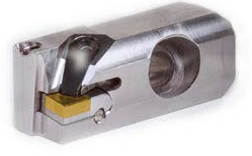
Open or extremely interrupted bores such as those found, for example, in the cast housings of gear pumps, are a challenge for fine machining. Until now the desired results, for example with regard to the parallel
alignment of the bores, could generally only be reliably achieved using single-bladed tools. Spindle tools or tools with blade and guide pads were used for this. These methods are effective, but also time-consuming.
In order to allow such bores to be machined faster and hence more cost-effectively, MAPAL has developed a
multi-bladed fine boring tool with guide pads. Thanks to the multiple cutting edges, the cycle time is significantly
reduced compared with single-bladed tools. The guide pads ensure the highest accuracy. The tool diameter can be set. When the feed rate for the machining is known, a single axial fine adjustment is necessary. This provides a uniform distribution of the material removal at the blades. This leads to long tool lives and a very good surface quality.
The tool can be fitted with HX or TEC blades, depending on the application. The HX blades with six cutting edges are
suitable for through bores. Blind bores and shoulders can be finely machined using TEC blades with four cutting edges. The EasyAdjust-System from MAPAL is used for clamping the blades. The heart of the system is an innovative cassette that stably holds the indexable insert with its six or four cutting edges without any play. The back taper of the minor cutting edge is already integrated into this cassette. The setting effort for the back taper is thus completely eliminated.
Due to the exact guidance of the cassette on a precision guide pin, the back taper remains unchanged even during diameter adjustments. The new finely adjustable tool where the number of blades and guide pads are adapted to the
diameter impresses in particular with the high accuracy of the results and the high cost-effectiveness.
Initial tests in practice have shown good results: In particular the tool achieves a parallel alignment of the bores of < 1 μm.
Contact Details
Related Glossary Terms
- boring
boring
Enlarging a hole that already has been drilled or cored. Generally, it is an operation of truing the previously drilled hole with a single-point, lathe-type tool. Boring is essentially internal turning, in that usually a single-point cutting tool forms the internal shape. Some tools are available with two cutting edges to balance cutting forces.
- feed
feed
Rate of change of position of the tool as a whole, relative to the workpiece while cutting.
- indexable insert
indexable insert
Replaceable tool that clamps into a tool body, drill, mill or other cutter body designed to accommodate inserts. Most inserts are made of cemented carbide. Often they are coated with a hard material. Other insert materials are ceramic, cermet, polycrystalline cubic boron nitride and polycrystalline diamond. The insert is used until dull, then indexed, or turned, to expose a fresh cutting edge. When the entire insert is dull, it is usually discarded. Some inserts can be resharpened.
- parallel
parallel
Strip or block of precision-ground stock used to elevate a workpiece, while keeping it parallel to the worktable, to prevent cutter/table contact.
